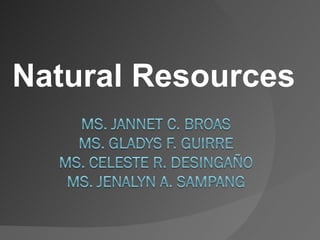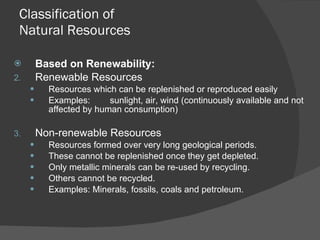Natural resources lecture
- 2. Resources are materials that can be used to satisfy human needs.
- 3. Classification of Natural Resources Based on Origin: Biotic Resources Resources obtained from the biosphere Examples: Animals, Birds, Fish Coal and petroleum are also considered biotic resources because they were formed from decayed organic matter Abiotic Resources Comprise of non-living things Examples: land, water, air, gold, iron, copper, silver
- 4. Classification of Natural Resources Based on Stage of Development: Potential Resources Resources which exist in a region and may be used in the future. Example: Mineral oil that exist in many parts of India is considered potential resources until it is drilled out and put into use. Actual Resources Resources which have been surveyed, their quantity and quality determined and are being used in present times. Examples: The petroleum and the natural gas which is obtained from the Bombay High Fields.
- 5. Classification of Natural Resources Based on Renewability: Renewable Resources Resources which can be replenished or reproduced easily Examples: sunlight, air, wind (continuously available and not affected by human consumption) Non-renewable Resources Resources formed over very long geological periods. These cannot be replenished once they get depleted. Only metallic minerals can be re-used by recycling. Others cannot be recycled. Examples: Minerals, fossils, coals and petroleum.
- 6. Examples of Renewable Resources
- 7. 1. Solar power Solar power is the technology of obtaining usable energy from the light of the sun. Solar energy has been used in many traditional technologies for centuries and has come into widespread use where other power supplies are absent, such as in remote locations and in space.
- 8. 1. Solar Energy refers to energy that is collected from sunlight. It can be applied in many ways, including: To generate electricity using photovoltaic solar cells To generate electricity using concentrated solar power To generate electricity by heating trapped air which rotates turbines in a Solar updraft tower Heat buildings, directly, through passive solar design Heat foodstuffs, through solar ovens Heat water or air for domestic hot water and space heating needs using solar-thermal panels Heat and cool air through use of solar chimneys
- 9. 2. Wind Power Wind power is the conversion of wind energy into more useful forms, usually electricity using wind turbines. Wind power is used in large scale wind farms for national electrical grids as well as in small individual turbines for providing electricity to rural residences or grid-isolated locations.
- 10. 3. Hydroelectric power/Wave power Hydropower or hydraulic power is the force or energy of moving water. It may be captured for some useful purpose. Hydropower was used for irrigation, and operation of various machines, such as watermills, textile machines, and sawmills. Undershot water wheels on the Orontes River in Hama, Syria A watermill in Belgium. Saint Anthony Falls
- 11. 4. Geothermal Energy Geothermal energy is energy obtained by tapping the heat of the earth itself, usually from kilometres deep into the Earth's crust. this energy derives from radioactive decay of elements like uranium and thorium in the Earth's core. This means that geothermal energy it is not a really a renewable source of energy at all; it just happens to be a very long-lived source. Krafla Geothermal Station in northeast Iceland
- 12. Examples of Non-Renewable Resources
- 13. 1. Fossil fuels Fossil fuels or mineral fuels are hydrocarbons found within the top layer of the earthâs crust. They range from very volatile materials with low carbon: hydrogen ratios like methane, to liquid petroleum to non-volatile materials composed of almost pure carbon, like anthracite coal. Often fossil fuels, such as coal, petroleum, and natural gas are considered non-renewable resources, as they do not naturally re-form at a rate that makes the way we use them sustainable.
- 14. Coal Black or blackish mineral substances formed from the compaction of ancient plant matter in tropical swamp conditions. Used as fuel and in chemical industry Classification of Coal accdg. to carbon content: Anthracite â shiny with 90% carbon Bituminous â shiny and dull patches with 75% carbon Lignite â woody, grading into peat about 50% carbon
- 15. Other Facts: 1700 â Britain was the worldâs largest coal producer 1800 â coal was carbonized commercially to produce coal gas for gas lighting and coke for melting iron ore. Half of 19 th century â study of by products such as coal tar, pitch and ammonia formed the basis of organic chemistry 20 th century â study of coal in organic chemistry led to the development of the plastic industry.
- 16. Petroleum Natural mineral oil, a thick greenish-brown flammable liquid found underground in permeable rocks. Consists of hydrocarbon mixed with oxygen, sulphur, nitrogen and other elements in varying proportions. Formed from the remains of marine plant and animal life which existed many millions of years ago.
- 17. Other Facts: Products from crude petroleum: Fuel oil Petrol Kerosene Diesel Lubricating oil Petroleum products and chemicals are used in large quantities in the manufacture of detergents, artificial fibres, plastics, insecticides, fertilizers, pharmaceuticals, toiletries and synthetic rubber.
- 18. 2. Mineral resources One of the major kinds of non-renewable resources. Mineral resources are not uniform throughout the earth. Wyoming coal mine. Coal, along with many other resources is harvested at a vastly unsustainable rate. A temporary oil drilling rig in Western Australia

















